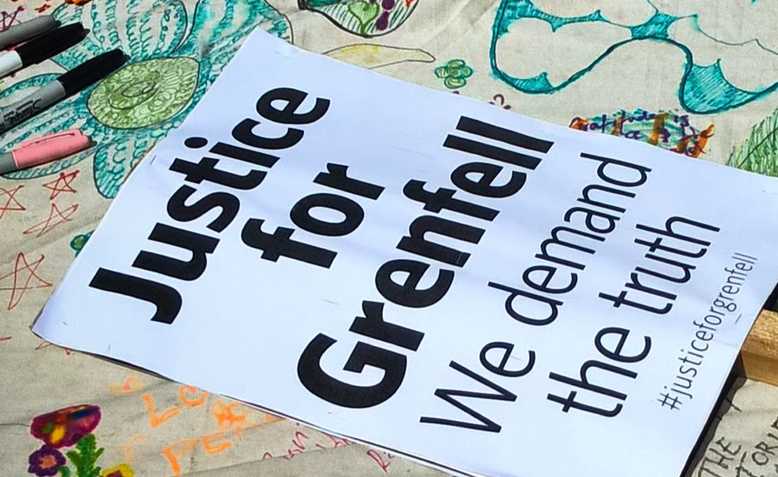 Justice for Grenfell placard, Photo: garryknight / Flickr
Justice for Grenfell placard, Photo: garryknight / Flickr
As the Grenfell inquiry continues, the blame lies squarely with governments and profiteers who have put private wealth before human life, argues Caitlin Southern.
The second phase of the inquiry into the Grenfell Tower fire, that killed 72 people and made many others homeless, has now heard evidence that the manufacturers of the RS5000 cladding, that enabled the catastrophic spread of the fire, were aware before the refurbishment that it was highly flammable.
Rather than cancelling manufacture and withdrawing the product from sale, they deliberately falsified the fire safety test in order to get the cladding approved and make a profit, despite the risk to life that it presented.
As early as 2015 the National House Building Council (NHBC) deemed RS5000 flammable and the manufacturer, Celotex, was subject to an official complaint by a building company that was using the product and faced financial losses should they have to remove and replace the cladding. Although it was ultimately deemed ‘acceptable’ for use, it was clearly not of a standard that most people would be happy to have in their homes.
Eight years before the tragedy that struck Grenfell, the Lakanal House fire in 2009 demonstrated the dangers of flammable building cladding when substandard, retrofitted cladding caused a fire to spread and kill six people. Despite repeated requests by the All-Party Parliamentary Fire Safety and Rescue Group, four successive Housing Ministers refused to meet with them to discuss measures to prevent such a situation happening again.
There was no review of the building regulations that allowed ‘Class 0’ panels to be used – a classification that permits flammable materials within the panel as long as the outer skin is of a non-flammable material such as aluminium.
The recommendation that sprinkler systems be made mandatory in high-rise accommodation was dismissed as too expensive on the basis of outdated cost estimates, with Eric Pickles condemning the Welsh government for adding to the cost of building when they decided to enforce it.
The commitment to deregulation – in particular the removal of vital health and safety protections – was built on the backs of both Blair and Thatcher, who were determined to cut through the ‘red tape’ that allegedly hampers free enterprise.
This was given a major boost in January 2012 when then-Prime Minister David Cameron outlined his vision to ‘kill off the health and safety culture for good’, dumping a raft of regulations that the government felt were an obstacle to the accumulation of wealth by business owners.
The Fire and Rescue Services Act 2004, which dismantled a number of national standards and statutory bodies, and the Regulatory Reform (Fire Safety) Order 2005, which gave owners and managers of properties the responsibility for risk assessment, but severely weakened the ability of the Fire and Rescue Service to enforce changes, was passed under New Labour[1].
It is not unique to the Conservative Party to deliberately roll back hard-won health and safety statutes, forcing workers and residents to risk death or disablement, in order to allow exploitative businesses to make a quick profit. When ministers were pushed to answer why they were overseeing the deregulation of fire safety the response seems to have been that fire deaths were falling and therefore there was no need to maintain the same standards. Apparently, the prevailing attitude was that a major incident is yet to happen so there is no need to worry about it.
The first phase of the inquiry focussed on the failure of the London Fire Brigade to adequately respond to the unprecedented situation at Grenfell Tower, with the media quickly condemning the firefighters for not responding quickly enough to a situation that no fire brigade in the country could have anticipated[2].
The authors admitted in their report that they had not referred to the inquiry’s own firefighting expert when making their conclusions about the culpability of the fire service, something that was not widely reported when it was published.
This second phase has not been pounced upon with the same ferocity, despite clearly showing that the fault lay with the manufacturers who knew that it was a serious fire risk, the ministers who deliberately watered down regulations, and the councils who chose to install the cladding despite multiple cases of similar cladding allowing fires to spread since the Lakanal House tragedy.
The Fire Brigades Union has said in its official response to the phase 1 report that they ‘expect ministers who were ultimately responsible for the failed fire safety policy over many decades, which has now been exposed by the Grenfell Tower fire, to answer for their failures in Phase 2’[3].
That this has not happened is not surprising. It is held dear by the policy makers in government that health and safety regulations are a nuisance rather than a vital protection.
The blame for the lives lost at Grenfell Tower in June 2017 lies squarely with those governments who spent successive parliaments deliberately undermining health and safety protections in order to allow the accumulation of profit at the expense of life. It does not lie with the firefighters who put their lives on the line to save those of others, or the training procedures that left frontline and control staff unprepared for this entirely preventable catastrophe.
The attempt by the official inquiry to bury this is both immensely disrespectful and extremely worrying, as it once again demonstrates the lengths that the establishment will go to in order to avoid accepting the blame for its own actions.
Notes
[2] Ibid
[3] Ibid p6
Join Revolution! May Day weekender in London
The world is changing fast. From tariffs and trade wars to the continuing genocide in Gaza to Starmer’s austerity 2.0.
Revolution! on Saturday 3 – Sunday 4 May brings together leading activists and authors to discuss the key questions of the moment and chart a strategy for the left.

